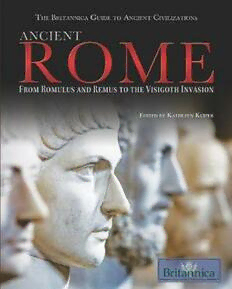
Ancient Rome: From Romulus and Remus to the Visigoth Invasion (The Britannica Guide to Ancient Civilizations) PDF
Preview Ancient Rome: From Romulus and Remus to the Visigoth Invasion (The Britannica Guide to Ancient Civilizations)
Published in 2011 by Britannica Educational Publishing (a trademark of Encyclopædia Britannica, Inc.) in association with Rosen Educational Services, LLC 29 East 21st Street, New York, NY 10010. Copyright © 2011 Encyclopædia Britannica, Inc. Britannica, Encyclopædia Britannica, and the Thistle logo are registered trademarks of Encyclopædia Britannica, Inc. All rights reserved. Rosen Educational Services materials copyright © 2011 Rosen Educational Services, LLC. All rights reserved. Distributed exclusively by Rosen Educational Services. For a listing of additional Britannica Educational Publishing titles, call toll free (800) 237-9932. First Edition Britannica Educational Publishing Michael I. Levy: Executive Editor J.E. Luebering: Senior Manager Marilyn L. Barton: Senior Coordinator, Production Control Steven Bosco: Director, Editorial Technologies Lisa S. Braucher: Senior Producer and Data Editor Yvette Charboneau: Senior Copy Editor Kathy Nakamura: Manager, Media Acquisition Kathleen Kuiper: Manager, Arts and Culture Rosen Educational Services Jeanne Nagle: Senior Editor Nelson Sá: Art Director Cindy Reiman: Photography Manager Matthew Cauli: Designer, Cover Design Introduction by Laura Loria Library of Congress Cataloging-in-Publication Data Ancient Rome: from Romulus and Remus to the Visigoth invasion / edited by Kathleen Kuiper.—1st ed. p. cm.—(The Britannica guide to ancient civilizations) “In association with Britannica Educational Publishing, Rosen Educational Services.” Includes bibliographical references and index. ISBN 978-1-61530-207-9 (eBook) 1. Rome—History. I. Kuiper, Kathleen. DG209.A55 2010 937—dc22 2009045443 On the cover: A phalanx of statues, currently housed in the Vatican Museum, stand as silent witnesses to the grandeur of ancient Rome. Ian Shive/Aurora/Getty Images Photo credit pp. 17, 39, 77, 104, and 153 Hulton Archive/Getty Images 19 CONTENTS Introduction 10 Chapter 1: Rome from its Origins to 264 BC 17 Early Italy 18 Historical Sources on Early Rome 19 Rome’s Foundation Myth 20 The Regal Period, 753–509 BC 21 The Foundation of the Republic 23 The Struggle of the Orders 24 The Consulship 26 The Dictatorship 26 The Senate 27 48 The Popular Assemblies 27 The Plebeian Tribunate 28 The Twelve Tables 30 Military Tribunes with Consular Power 30 Social and Economic Changes 31 The Latin League 33 Roman Expansion in Italy 34 The Samnite Wars 35 The Pyrrhic War, 280–275 BC 37 Chapter 2: The Middle Republic (264–133 BC) 39 First Punic War (264–241 BC) 39 Between the First and Second Punic Wars (241–218 BC) 41 Second Punic War (218–201 BC) 42 Campaigns in Sicily and Spain 45 The War in Africa 47 The Establishment of Roman Hegemony in the 54 Mediterranean World 48 Roman Expansion in the Eastern Mediterranean 49 Roman Expansion in the Western Mediterranean 53 Explanations of Roman Expansion 56 Beginnings of Provincial Administration 57 Transformation During the Middle Republic 58 Citizenship and Politics in the Middle Republic 58 75 Culture and Religion 61 Economy and Society 66 Social Changes 72 Rome and Italy 74 Chapter 3: The Late Republic (133–31 BC) 77 Aftermath of Victories 77 Changes in Provincial Administration 78 Social and Economic Ills 78 The Reform Movement of the Gracchi (133–121 BC) 78 The Program and Career of Tiberius 90 Sempronius Gracchus 79 The Program and Career of Gaius Sempronius Gracchus 81 War Against Jugurtha 82 The Career of Gaius Marius 83 Events in Asia 85 Developments in Italy 86 Civil War and the Rule of Lucius Sulla 87 The Early Career of Pompey 90 Pompey and Crassus 92 Political Suspicion and Violence 94 The Final Collapse of the Roman Republic (59–44 BC) 95 Political Maneuvers 96 Civil War 97 The Dictatorship and Assassination of Caesar 98 The Triumvirate and Octavian’s Achievement of Sole Power 98 99 Intellectual Life of the Late Republic 100 Grammar and Rhetoric 101 Law and History 102 Philosophy and Poetry 102 Chapter 4: The Early Roman Empire (31 BC–AD 193) 104 The Consolidation of the Empire Under the Julio-Claudians 104 109 The Establishment of the Principate Under Augustus 105 The Roman Senate and the Urban Magistracies 107 The Equestrian Order 109 Administration of Rome and Italy 110 Administration of the Provinces 111 Emperor Worship 112 The Army 113 Foreign Policy 115 Economic Life 117 Augustan Art and Literature 118 Appraisal of Augustus 120 136 The Succession 121 Growth of the Empire Under the Flavians and Antonines 124 The Flavian Emperors 124 The Early Antonine Emperors: Nerva and Trajan 127 Hadrian and the Other Antonine Emperors 129 The Empire in the Second Century 132 Trend to Absolute Monarchy 133 Political Life 134 Rome and Italy 135 Developments in the Provinces 137 The Army 148 Cultural Life 149 Chapter 5: The Later Roman Empire 153 The Dynasty of the Severi (AD 193–235) 153 142 Septimius Severus 153 Caracalla 157 Macrinus 157 Elagabalus and Severus Alexander 158 Religious and Cultural Life in the Third Century 159 The Rise of Christianity 161 Cultural Life from the Antonines to Constantine 163 181 Military Anarchy and the Disintegration of the Empire (235–270) 164 The Barbarian Invasions 166 Difficulties in the East 167 Economic and Social Crisis 168 The Recovery of the Empire and the Establishment of the Dominate (270–337) 170 Diocletian 172 Struggle for Power 177 The Reign of Constantine 178 The Roman Empire Under the Fourth-Century Successors of Constantine 181 The Reign of Julian 183 190 The Reign of Valentinian and Valens 184 The Reign of Gratian and Theodosius I 186 Social and Economic Conditions 188 The Remnants of Pagan Culture 190 The Christian Church 191 The Eclipse of the Roman Empire in the West (c. 395–500) and the German Migrations 193 The Beginning of Germanic Hegemony in the West 194 Barbarian Kingdoms 195 Analysis of the Decline and Fall 196 Appendix A: Table of Roman Emperors from 27 BC through AD 476 198 Appendix B: Ancient Italic Peoples 202 Glossary 213 Bibliography 215 Index 221 192
